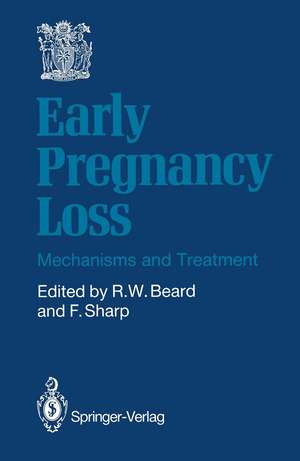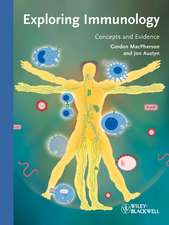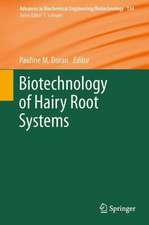Early Pregnancy Loss: Mechanisms and Treatment
Editat de Richard W. Beard, Frank Sharpen Limba Engleză Paperback – 7 dec 2011
Preț: 373.33 lei
Preț vechi: 392.97 lei
-5% Nou
Puncte Express: 560
Preț estimativ în valută:
71.44€ • 74.14$ • 59.72£
71.44€ • 74.14$ • 59.72£
Carte tipărită la comandă
Livrare economică 17-31 martie
Preluare comenzi: 021 569.72.76
Specificații
ISBN-13: 9781447116608
ISBN-10: 1447116607
Pagini: 464
Ilustrații: XVIII, 442 p.
Dimensiuni: 140 x 216 x 24 mm
Greutate: 0.53 kg
Ediția:Softcover reprint of the original 1st ed. 1988
Editura: SPRINGER LONDON
Colecția Springer
Locul publicării:London, United Kingdom
ISBN-10: 1447116607
Pagini: 464
Ilustrații: XVIII, 442 p.
Dimensiuni: 140 x 216 x 24 mm
Greutate: 0.53 kg
Ediția:Softcover reprint of the original 1st ed. 1988
Editura: SPRINGER LONDON
Colecția Springer
Locul publicării:London, United Kingdom
Public țintă
ResearchCuprins
Section 1 – The Clinical Problem.- Clinical associations of recurrent miscarriage.- The epidemiology of repeated abortion.- Discussion.- A prospective study of spontaneous abortion.- Discussion.- Clinical and immunological significance of anti-phospholipid antibodies.- Discussion.- Section 2 – Experimental Models of Early Pregnancy Failure.- Anatomical and immunological aspects of fetal death in the Mus musculus/Mus caroli model of pregnancy failure.- Discussion.- Genetic aspects of the CBA × DBA/2 and B1O × B10.A models of murine pregnancy failure and its prevention by lymphocyte immunisation.- Discussion.- Effects of feto-maternal major histocompatibility differences on litter size in pigs.- Discussion.- A non-genetic development defect in trophoblast formation in the horse: immunological aspects of a model of early abortion.- Discussion.- Section 3 – Studies of the Normal and Failing Placenta in Early Pregnancy.- Placental pathology in spontaneous miscarriage.- Discussion.- Early human trophoblast.- Discussion.- The decidua in early pregnancy.- Discussion.- Early pregnancy failure: biochemical and biophysical assessment.- Discussion.- Haemostasis and fibrinolysis in human normal placentae: possible role in early pregnancy failure.- Discussion.- Section 4 – Factors Which Maintain Pregnancy at and Immediately After Implantation.- Chairman’s introductory remarks.- Antigen expression by cells of the conceptus before, during and after implantation.- Discussion.- Host immunoregulatory mechanisms and the success of the conceptus fertilised in vivo and in vitro.- Discussion.- Interplay of oestrogens, progesterone and polypeptide growth factors at about the time of implantation.- Discussion.- Prostaglandins and other non-steroidal mediators at and immediatelyafter implantation.- Discussion.- Section 5 – Genetic Causes of Early Pregnancy Failure.- Is there a t complex in man?.- Discussion.- Immunogenetic factors influencing the survival of the fetal allograft.- Discussion.- The cytogenetics of spontaneous abortion in humans.- Discussion.- The biology of trophoblastic disease: complete and partial hydatidiform moles.- Discussion.- Section 6 – Techniques, Treatment Criteria and Outcome of Immunotherapy in Recurrent Abortion.- Chairman’s introductory remarks.- Successes and failures of immunisation for recurrent spontaneous abortion.- Discussion.- Pregnancy outcome in couples with recurrent abortions following immunological evaluation and therapy.- Discussion.- Belgian experience with repeat immunisation in recurrent spontaneous abortions.- Discussion.- Immunotherapy in recurrent spontaneous abortion: who, how, outcome.- Discussion.- Human MHC antigens and paternal leucocyte injections in recurrent spontaneous abortions.- Discussion.- Trophoblast membrane infusion (TMI) in the treatment of recurrent spontaneous abortion.- Discussion.- Section 7 – Other Methods of Treatment.- Use of cervical cerclage in patients with recurrent first trimester abortion.- Discussion.- Early recurrent pregnancy failure: treatment with human chorionic gonadotrophin.- Discussion.- Recurrent abortion: the role of psychotherapy.- Discussion.









